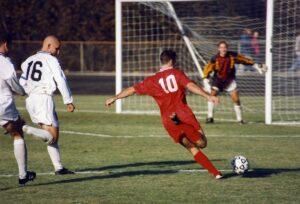FOOTBALL: LAWS OF THE GAME
Football, also known as Baron Pier or soccer (in the United States), is a sport in which 22 players are divided into two teams of 11 members whose goal is to face each other and throw in the ball. Team goals. .. Score goals with your opponent.
To score a goal, soccer players must use parts of their body other than their feet, head, or hands and arms because of the penalty imposed.
Soccer is played on artificial or natural turf fields and each team has 11 players. As a defender, midfielder, forward, and goalkeeper, you are responsible for touching the ball with your own hands and never exceeding your goal.
Therefore, soccer rolls the ball to reach the opponent’s court or goal to score a goal. On the other hand, other teams must attack through tactics and strategies.

Soccer is played according to a set of rules known as the rules of the game. The match is played with one round ball (soccer ball). Two teams of 11 players compete and score for the ball in the other team’s goals. The team with the most goals at the end of the match will be the winner, and if they score the same number of goals, they will be considered equal.
The main rule is that players (except the goalkeeper) cannot intentionally touch the ball with their hands or arms (though they are allowed to use their hands to throw-in). Players typically use their feet to move the ball, but they can use any part of their body except their hands or arms.
In a regular match, players try to push the ball into the opponent’s goal by controlling the ball individually, such as dribbling, passing the ball to a teammate, or kicking the ball towards the opponent’s goal. .. It is always protected by a gatekeeper (also known as a gatekeeper). Players on the opposing team try to regain control of the ball by intercepting the pass and working on the player controlling the ball (although physical contact between opponents is limited). Soccer is generally a fluid game and only stops when the ball leaves the field or when the referee stops the game due to some breach.

At the professional level, few goals are scored in most matches. For example, during the 2005-2006 season, the English Premier League averaged 2.48 goals per match.
The rules of the game do not specify the position of any player other than the goalkeeper, but over time specialist players have evolved to specific positions on the field. In general, these specialists fall into three main categories. Scorer (or forward). The main function is goal scoring. A defender who specializes in preventing opponents from scoring.
Conversely, the midfielder stealing the ball retains possession of the ball and connects with the forward. Players in these positions are called outfield players. To distinguish them from goalkeepers. The position of the outfield player depends on which side of the field the player spends the most time on. For example, center, back right, left midfielder. The 10 outfielders can be placed in any of these positions in any combination (for example, 4 defenders, 4 midfielders and 2 forwards, or 3 defenders, 3 midfielders, and Four forwards are common).

The number of players in each position determines the playing style of the team. The more forwards you have and the less defense you have, the more aggressive and aggressive your game system is, and the more aggressive your reverse system is. Players can use most of the game in specific positions, but they have no movement restrictions and can change positions at any time. Designing a player’s position in the playing field is called training. The team coach decides the formation and tactics.





